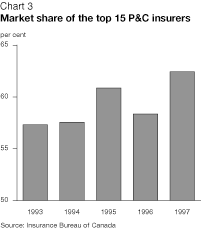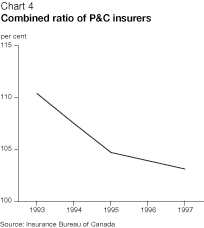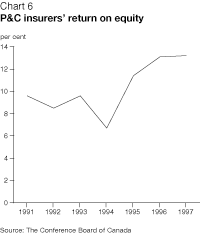|
|
- All Financial Sector Fact Sheets -
Canada’s Financial Services Sector
Property and Casualty Insurance in Canada
April 1999
Overview
- The property and casualty (P&C) insurance industry in Canada provides coverage for all risks other than life and generates more than $18 billion in net premiums annually. Most premiums are accounted for by automobile, property and liability insurance.
- P&C insurers and their intermediaries employ over 100,000 people in Canada.
- The industry has a wide variety of participants, ranging beyond direct insurers to include reinsurers, government participation in personal auto insurance, and self-insurance arrangements such as reciprocal insurance exchanges and "captive" insurers.
- Canada's P&C industry has over 230 private insurers, the largest of these having a market share of 8 per cent. The industry is viewed as being well capitalized by market analysts.
- The profitability of P&C insurers has increased in recent years largely because of lower underwriting losses and larger investment gains.
- The Property and Casualty Insurance Compensation Corporation is an industry-financed policyholder protection scheme for most personal lines which guarantees payments of up to $250,000 per claim less deductibles, should an insurer become insolvent.
- Entry into the direct P&C insurance market in Canada is comparatively straightforward for financially sound and experienced entities. Foreign companies can enter through a branch as well as through a separately capitalized subsidiary.
- Foreign participants have a strong position in Canada's P&C market, accounting for approximately 68 per cent of net premiums earned.
- The federal government and the provinces share jurisdiction over insurance regulation. Although P&C insurers can be incorporated under either level of government, the federal government supervises three-quarters of the companies, which account for more than 80 per cent of total business.
Introduction
The Canadian property and casualty (P&C) insurance industry is generally defined as including all lines of insurance other than life.1 Over half of the more than $18 billion in annual premiums for P&C insurance is for automobile insurance lines; most of the remainder is for property and liability insurance lines (see Chart 1). Government-owned corporations earn an additional $4.3 billion in auto insurance premiums.2

Canada's P&C insurance industry is part of the global P&C insurance market. There is substantial participation in Canada's insurance markets by foreign direct insurers and by international reinsurers (reinsurers are discussed later in this information sheet). Many factors affecting the availability of P&C insurance lines are, however, specific to Canada, such as Canada's legal and regulatory environment.
Structure of the P&C industry in Canada
The diversity of P&C insurance lines available in Canada is reflected in the large number and wide variety of industry participants. There are more than 230 insurers active in Canada, including both Canadian-incorporated companies and branches of foreign companies licensed in Canada. Both domestic and foreign firms may issue P&C insurance directly to business and personal clients. Besides the 40,000 employees and agents of these companies, Canada has an extensive network of stand-alone insurance intermediaries employing a further 60,000. These intermediaries include independent brokers and agents as well as independent insurance adjusters and appraisers (adjusters and appraisers participate in the assessment of P&C insurance claims). Employment in the P&C industry is spread throughout the country but is concentrated in Ontario and Quebec (see Chart 2).

In line with international trends, Canada's P&C market has been undergoing a period of consolidation (see Chart 3). In 1980, the 26 largest insurers wrote 50 per cent of net premiums (net premiums are net of reinsurance). As of 1997, the top 10 insurers served half the market (see the appendix for a list of the top ten insurers by net premiums written). However, despite the ongoing consolidation, no single P&C insurer has more than 10 per cent of the Canadian market. In addition, 24 P&C insurers entered the Canadian market in the 1990s.

Canada's P&C market has attracted considerable competition from foreign companies. Seven of the ten largest insurers are foreign-owned, and foreign insurers account for 68 per cent of net premiums earned. They are allowed to enter Canada through branches as well as through separately capitalized subsidiaries. Foreign insurers with branches in Canada must vest assets in Canada to ensure policyholder protection.
The worldwide insurance market is an important backstop to Canada's P&C insurers, who ceded business worth $900 million to reinsurers in 1997 (direct insurers pay premiums to reinsurers who, in exchange, assume a portion of the risk from direct insurers). Although this is only 5 per cent of net premiums written, appropriate use of reinsurance is particularly important in managing low probability-high loss events such as severe weather. Reinsurers and reinsurance brokers are not required to register with Canadian supervisory authorities but may choose to do so. Canada's direct insurers are subject to regulatory controls in their use of reinsurers. These controls include a focus on the financial health of reinsurance companies as well as a 75-per-cent limit on the percentage of a direct insurer's business that can be reinsured. In addition, there is a 25-per-cent limit on the amount of business that can be ceded by a direct insurer to unregulated reinsurers.
For direct insurers, an alternative to reinsurance is the formation of insurance pools under which direct insurers agree to share certain types of risks. Examples of insurance pools in Canada include the Canadian Industrial Risk Insurers and the Canadian Aviation Insurance Group.
Government-owned corporations also provide some P&C insurance. The area of greatest government participation is auto insurance; provincial public companies supply this type of insurance in British Columbia, Manitoba, Saskatchewan and Quebec.3 These public companies account for about 32 per cent of the Canadian auto insurance market.
Some firms also participate in various self-insurance arrangements. One such mechanism is a reciprocal insurance exchange, whereby a group in a related activity agrees to share certain kinds of risk. In Canada, a number of school boards, hospitals and universities have established such reciprocal exchanges.
Another self-insurance mechanism of increasing importance is the ownership, by one or more Canadian firms, of a "captive" insurer. Captive insurers are firms, typically owned by non-insurers, which undertake some or all of their owners' insurance business. As of December 1998, 16 captive insurers had been established under the terms of British Columbia's Insurance (Captive Company) Act. Under this act, captive insurers can benefit from arrangements such as less onerous licensing requirements, which allow for lower minimum capital. Other captive insurers established by Canadian companies are domiciled in offshore centres, such as Bermuda or the Bahamas, on the condition that the captives limit themselves to providing a reinsurance function to the Canadian market.
Canadian financial institutions in other areas of the financial sector are subject to legislative and regulatory restrictions on their participation in Canada's P&C industry. For example, banks and other federally chartered deposit-taking institutions may own insurance underwriting subsidiaries, but they are not permitted to issue insurance policies through their branches. In particular, banks are generally not permitted to become directly involved in the retailing of insurance through their branches, but they are allowed limited participation in some lines related to their banking activities, such as credit insurance and travel insurance. Although every major bank (except Bank of Montreal), as well as Canada Trust, controls or owns an insurance underwriting subsidiary, the total market share for these entities is less than 2 per cent.
Profitability and investment
The business of P&C insurers can be divided into two segments: underwriting and investments. As in other countries, P&C insurance activities in Canada normally result in underwriting losses for most major product lines.4 This means that premiums paid for policies each year do not generate enough revenues to cover outgoing claims and expenses. However, these underwriting losses are normally more than offset by the investment income generated from assets held by the industry. One measurement of underwriting losses is the combined ratio – the ratio of the sum of claims incurred and operating expenses over net premiums earned. A ratio greater than 100 per cent indicates an underwriting loss. Although underwriting losses decreased from 1993 to 1997 (see Chart 4), the industry as a whole continues to rely on investment income to maintain profitability. Thus, as in other countries, the profitability of P&C insurers is sensitive to small changes in investment returns.

While the combined ratio is a useful measure to compare one P&C company with another, return on equity allows comparison between different types of financial institutions. Despite the fact that, as a percentage of assets, P&C companies normally carry three times as much capital as deposit-taking institutions and twice as much capital as life insurers, their average return on equity from 1991 to 1997 exceeded that of all financial institutions except securities dealers (see Chart 5).

Consistent with the experience in many other countries, the profitability of the Canadian P&C industry is cyclical. Profitability fell in the early 1990s but recovered strongly between 1994 and 1997 (see Chart 6).
P&C policies are often subject to renewal every year, and insurance companies generally match their liabilities by investing in short-term or highly liquid investments, such as government and corporate bonds, which tend to be highly interest rate sensitive.

Under the 1992 federal financial sector reforms, investment rules for federally regulated P&C companies moved from explicitly regulating the quality of investments (known as the "legal-for-life" rules) to a "prudent portfolio" approach.5 This approach provides more scope for portfolio diversification strategies and for the use of derivative financial products for hedging purposes. The financial reforms also expanded the in-house lending powers of P&C insurers to include full commercial lending powers, provided they have a capital base of at least $25 million and receive supervisory approval.
Policyholder protection and capital
P&C direct insurers in Canada are required to satisfy regulatory authorities that their policy reserves are sufficient to meet the anticipated requirements of their policyholders. In addition, they must satisfy capital requirements, which are expressed as a minimum percentage by which assets must exceed liabilities. For federally regulated insurers this is generally known as the "Section 516" Minimum Asset Test, which refers to a section of the Insurance Companies Act enacted as part of the 1992 federal financial sector reforms. Industry solvency has improved over the last few years and the industry is viewed as being well capitalized by insurance industry analysts.
Additional protection for many Canadian policyholders is provided by the industry- run Property and Casualty Insurance Compensation Corporation (PACICC), which has guaranteed most P&C insurance policies in Canada, up to certain limits, since 1988.6 PACICC membership is required in all Canadian jurisdictions for the licensing of P&C insurers in PACICC-covered lines. Although PACICC is currently in the process of raising a $30-million reserve fund, it relies primarily on its ability to levy assessments from member P&C insurers when insolvencies arise.
Regulatory and legal environment
As the federal government and the provinces share jurisdiction over insurance matters in Canada, both levels of government are involved in the regulation and supervision of participants in Canada's P&C industry.
Of the more than 230 P&C insurers active in Canada, including all branches of foreign companies, about three-quarters of the companies holding more than 80 per cent of total business are supervised by the federal government through the Office of the Superintendent of Financial Institutions. Federally regulated companies must, however, also be licensed in each province and territory in which they undertake insurance activities. Provincial and territorial governments have responsibility for the terms and conditions of insurance contracts as well as the licensing of agents, brokers and independent adjusters.
Federal, provincial and territorial regulators meet on a formal basis twice a year through their membership on the Canadian Council of Insurance Regulators. One of their continuing activities is the harmonization of licensing and other requirements. Additional efforts towards harmonization are being made by the Atlantic provinces.
The overall approach to regulation in Canada is that P&C insurers are generally required to satisfy regulatory authorities that they have sufficient resources to meet their commitments to policyholders. Insurers compete with regard to rates, terms and conditions of insurance policies. Canadians are also permitted to purchase insurance from insurers not licensed in Canada. However, the extent to which these unlicensed insurers can solicit business in Canada from Canadians is strictly limited and monitored by the regulatory authorities. As in other jurisdictions, marine insurance is exempt from federal regulation in Canada.
Developments in major P&C insurance lines
Automobile insurance includes insurance connected with personal liability and property damage tied to the use of personal and commercial vehicles. Private sector insurers generate more than $9.3 billion annually in auto insurance premiums, with government insurers accounting for an additional $4.3 billion in four of Canada's ten provinces.
Ontario is the largest private auto insurance market in Canada, and the industry has focused on recent changes to Ontario's legislative framework. Ontario introduced a system of no-fault auto insurance in 1990 in which accident victims receive compensation regardless of fault, with limited recourse to courts for further compensation.
Although the system has been modified twice since then, requiring insurers to retrain staff and incur other expenses, very few companies have withdrawn from the Ontario auto insurance market.
Liability insurance lines in Canada, which include public liability, employers' liability and the growing field of product liability, generate about $1.7 billion in annual premiums. Availability of liability insurance was an issue in the mid-1980s when international insurance markets, focusing on record-breaking court settlements in the United States, began to avoid the Canadian market due to a concern that a similar situation would develop in Canada. This concern has dissipated to a large extent as international markets have become aware of many important differences between the Canadian and American legal systems. Punitive damages are rarely awarded by Canadian courts, unlike in the United States.
The four costliest storms in Canadian history occurred in 1995, 1996, 1997 and 1998. Of these, the 1998 ice storm in Ontario and Quebec was the largest single event to ever confront the Canadian P&C insurance industry. Nearly 700,000 claims were made, the second largest single-event total in North America, behind only Hurricane Andrew's 710,000 claims. Ice storm losses exceeded $1.4 billion and made up more than 6 per cent of total P&C insurance losses in Canada in 1998. In most years total catastrophic losses make up about 1 per cent of total losses. The industry was well positioned to weather these losses.
In February 1998, the federal government passed legislation allowing P&C insurers to set aside earthquake premiums as reserves – unearned and untaxed. This was in recognition of the fact that a major earthquake in a heavily populated area of Canada could devastate Canadian insurers. In order to further prepare for this eventuality, the Office of the Superintendent of Financial Institutions has issued guidelines requiring insurers7 to estimate the probable maximum loss from a 250-year earthquake.8 Insurers must have sufficient financial resources to cover their probable maximum loss.
Appendix
Top ten P&C insurers in Canada by net premiums written (1997)
| Name | Country of origin | Net premiums written (in thousands of dollars) |
|---|---|---|
| The General Accident Assurance | ||
| Company of Canada | UK | 1,430,319 |
| The Co-operators Group Limited | Canada | 1,123,605 |
| Royal & SunAlliance Canada | UK | 1,118,823 |
| ING Canada | The Netherlands | 1,118,610 |
| AXA Canada Inc. | France | 867,318 |
| State Farm Insurance Companies | USA | 816,549 |
| The Economical Insurance Group | Canada | 686,038 |
| Wawanesa Mutual Insurance Company | Canada | 643,196 |
| Zurich Canada | Switzerland | 601,736 |
| Liberty Mutual Group | USA | 574,923 |
| Source: Canadian Insurance
|
||
1 For a listing of Canadian P&C insurance lines, see the schedule to the federal Insurance Companies Act. (return)
2 This information sheet deals primarily with insurance provided through private companies. Unless otherwise stated, all descriptions and data exclude insurance provided through public sector entities. (return)
3 In B.C., Manitoba and Saskatchewan, public companies supply collision and liability insurance. In Quebec, public companies provide only liability insurance, leaving collision insurance to private companies. (return)
4 The Canadian P&C industry has experienced underwriting losses since 1978, the year P&C insurers were first required to report financial statements according to Generally Accepted Accounting Principles. (return)
5 Under this approach, an institution is required to establish and adhere to lending and investment policies that a "reasonable and prudent person" would apply. The Office of the Superintendent of Financial Institutions has issued guidelines on what this would mean in practice. (return)
6 PACICC covers policies up to $250,000 and will refund 70 per cent of unused (prepaid) premiums, up to $700, from the date of the insurer's collapse to the expiration of the policy. (return)
7 Presently, only insurers with exposure in B.C. and Quebec are required to adhere to these guidelines, although all insurers are encouraged to do so. (return)
8 A 250-year earthquake is the highest magnitude earthquake that is expected to occur at least once every 250 years. (return)
This is part of a series of short monographs by the Department of Finance describing the Canadian financial system. Copies are available from: The Department of Finance, 140 O'Connor Street, Ottawa, Ontario K1A 0G5.
| Last Updated: 2004-07-14 | |||||